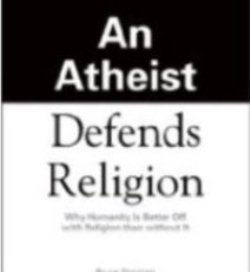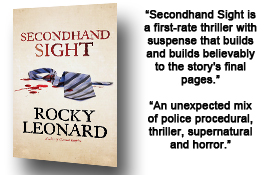 Author Bruce Sheiman approaches the debate between theists and atheists about whether God exists from a unique point of view.
Author Bruce Sheiman approaches the debate between theists and atheists about whether God exists from a unique point of view.
He is a professed atheist who defends the right of religious people to have their faith. He touts the psychological and physical health benefit one may derive from placing hope and faith in their Creator.
Sheiman coined a term to differentiate himself as an atheist (one who doesn’t believe in God personally) to Richard Dawkins and his fan club as antitheists, meaning people with a militant atheistic agenda. Antitheists not only reject God for themselves but actively campaign to eradicate faith in others.
It’s very helpful to understand the difference. In a section of his book titled “Scientific Materialism and Relativism“ Sheiman writes,
In the traditional evolutionary view, there is no difference between humans and animals, since both are driven by the same survival and gene replication imperatives. On the plus side, this may lead many people to respect all living creatures. On the negative side and in the extreme, this can lead to species relativism: the idea that humans are not the pinnacles of creation; we are no different from other creatures. (p41)
A little later Sheiman clarifies that point, adding,
…[b]ut the second implication is very disturbing. If humans are animals and our lives are not divinely inspired, the edifice of Judeo-Christian morality about the sanctity of human life is discredited. God is dead and we should recognize ourselves as Darwinian primates who enjoy no special status compared to other animals. Therefore, not only are abortion and euthanasia permissible, but so might be infanticide. (pg 42)
Unfortunately, Planned Parenthood agrees with that position. Their representative actually testified before Congress that the organization supports the position that whether the baby born alive should be allowed to leave the hospital alive should remain within the discretion of the mother.
Sheiman admires the idea of treating animals more humanely, but not treating humans more like animals. On this point, we agree completely. That’s why I volunteer with the local Humane Society. The sad, brutal fact of animal cruelty makes me wonder about the arguments by some atheists claiming that evil doesn’t actually exist in this world.
I’ve read arguments claiming that people set fire to an cat, throw a dog from a moving car, or hit a beagle with the claw end of a hammer because of some genetic defect or an equally preposterous “social excuse” like low self esteem, or peer pressure. Atheist philosopher Sam Harris argues against the existence of free, insisting that people who rape, torture, or murder have no real choice but to rape, torture, or murder. His claim implies that society is being unjust by punishing a criminal for his crimes, under the premise that the criminal has no real choice, because free will allegedly doesn’t exist.
Sheiman concludes,
At some point in our history, we transitioned from human being to being humane. Making that transition was facilitated by religion, the concept of being created in the image of God. And even though I do believe we have progressed as a moral species, it is still too early to dismiss religion. (pg 45)
The author explores a variety of Eastern religions and compares Buddhism, Hinduism, and how what he terms “parallel traditions” interpret among others the concepts of soul, God, sin, heaven and evil. He obviously did his homework on theism. He discusses in some detail the mental and physical health benefits of religious faith and how some atheists have abused history in an effort to discredit religion. Interestingly, Sheiman speculates,
In the atheist’s mind, if a religious person does something bad, it’s the fault of religion; hence, religion is evil. If a religious person does something good, it was done for a religious reason and therefore does not count. (pg 93)
It would appear that Sheiman tries to be more than fair. Even though he doesn’t believe in God, he is respectful of religious believers. He points out that you don’t have to be religious to be a decent person, offering himself as a reasonable example through his prose. At the same time, he doesn’t deny that for the most part, belief in God gives a majority of people with faith a happier life and less fear of death.
Unlike those who twist Bible passages that mention slavery to suggest those references imply a tacit approval of slavery by God, Instead, Sheiman credits Christians with the abolition of slavery and religious seekers for the origin of science and technology. He identifies scientism versus science accurately, harshly critical of the former while eloquently defending the latter.
He was absolutely correct to point out that biologist Jerry Coyne wrote:
Evolutionary psychology suffers from the scientific equivalent of megalomania. Most of its adherents are convinced that virtually every human action or feeling was put directly into our brains by natural selection.” Evolutionary psychology certainly makes sense when used to explain human mate choice, for example, but seems implausible when used to explain complex cultural phenomena such as religion. Devout believers would say they are religious because they seek to connect with and serve God, not to reproduce their genes. (pg 161 in Why Evolution is True)
Sheiman offered in reply something I might have written myself:
When prominent atheists claim religion is a “delusion” that “poisons everything” and the “root of all evil”, it is easy to understand why religious people feel that science threatens their beliefs.
My favorite chapter of the book was titled The Existential Implications of Science: Does Life Have a Purpose? In the section where Sheiman asks, Can we create something from nothing? he introduces a formula called CARL. The equation reads,
Human Life = laws of physics x CARL x 3.5 billion years. (CARL = Chance + Accident + Randomness + Luck)
Sheiman writes, “the only way humanity is special, according to science, is in terms of probability”, seeming to echo my perceived existential probability problem, offering the following “logical” equations:
Phase One: Random Creation of Multiverses = Our physical universe
Phase Two: Blind Laws of Physics + Chance = Simple Life (abiogenesis)
Phase Three: Simple Life + Genetic Randomness = Complex Life
Phase Four: Complex Life + More Accidents = Mind. (pg 204)
What scientists are essentially saying is not only are we the laws of physics plus accidents, but that even the laws of physics as we know them are a result of blind chance. To explain, let me introduce you to the anthropic principle, which has been proposed by some scientists as a way to explain how it is that our universe seems perfectly calibrated to accommodate life. We live in the universe where the the numerous constants of physics are astonishingly and exquisitely fine tuned to allow biological complexity to develop–what some have called the “Goldilocks universe.” The English physicist Roger Penrose estimated that the odds against our cosmos arising by chance with its exact constant values is about one in 10 to the 300th power, a figure far greater than the number of atomic particles believed to exist in the universe therefore, the anthropic principle prose is a problem for mainstream science. It would seem to imply some kind of design for life. (pg 204)
This section resonated with me personally so much because of my own existential equation, which I have coined the Big Picture. In my own existential equation, the variables were slightly different, and looked more like this:
Life = Big Bang + inflation + abiogenesis + speciation + natural selection + X
…where X represents divine intervention by God or some rather unbelievable good luck, depending on whether or not one believes that the universe was created on purpose or by accident. Sheiman continued,
Evolution already presupposes something miraculous—life. To realize phase Two in the above sequence (Blind Laws of Physics + Chance = Simple Life), the physicist Paul Davies suggests that the probability of producing a small virus from Earth’s primordial soup after of billion years is one in 10 to the 2 millionth power, which is greater than the chances of flipping heads on according 6 million times in a row.
Phase One is infinitely more improbable than Phase Two. It’s not improving the odds, because the improbabilities multiply together to give you the true odds of life as we know it. I won’t quibble with Sheiman for adding the probabilities instead of multiplying them. He wrote,
Therefore the entire structure of reality is built on CARL. And when we add up the probabilities at each of the four stages of cosmic evolution, even providing from many billions of years, the likelihood that a sentient Bruce Sheiman could have arisen to of written to write this sentence is not one in 1 trillion or 1 in a dectilion (1 followed by 33 zeroes) and or even one in the Google (1 followed by 100 zeroes) but one in near infinity. (Page 205)
Stressing his impartiality, Sheiman adds, “I must again assert that I only believe in natural science and I do not believe in God. But even for a secular materialist like me, this stringently reductionist conception of cosmic evolution leaves me stone cold. It is as implausible as a God-given miracle.” (pg 206)
I would argue that it’s much more implausible given millions of accounts of supernatural experiences, but why quibble when Mr. Sheiman is hammering home so many of my points for me?
Sheiman even makes the same argument I’ve made for considering the impact of entropy, writing
The propensity for matter and energy to self-organize in novel and unpredictable ways is a conspicuous feature of nature; it goes against the laws of thermodynamics (entropy) and cannot be explained by the known laws of physics. But according to conventional science, it’s all explained by a highly improbable confluence of accidents. And if you take “accidents” out of the life-creation equation, we would be left with nothing. (pg 207)
Sheiman argues,
I am dissatisfied with the scientific explanation for our universe. Science does not offer an intellectually or emotionally satisfying explanation for:
- The enormously improbable configuration of the universe capable of supporting life.
- The emergence of life, even the first single celled organism.
- The development of complex life and human consciousness. (pg 219)
Sheiman attempts to construct a third way: an intelligent universe and design without a designer, offering a definition of a purposeful life without a Creator.
Sheiman concludes his tome by writiing,
Throughout this book I have argued for a third way a compromise path between two polar opposites. The universe displays intelligence, but there is no higher intelligence. The universe displays creativity, but there is no Creator God. The universe displays design, but there is no great designer. The universe displays purpose in organized complexity, but there is no supreme being behind it.
Finally, there we must disagree, because design without a designer and creation without a Creator makes no logical sense. Even so, I highly recommend this book if you are interested in some interesting thoughts from a unique perspective.

Speak Your Mind